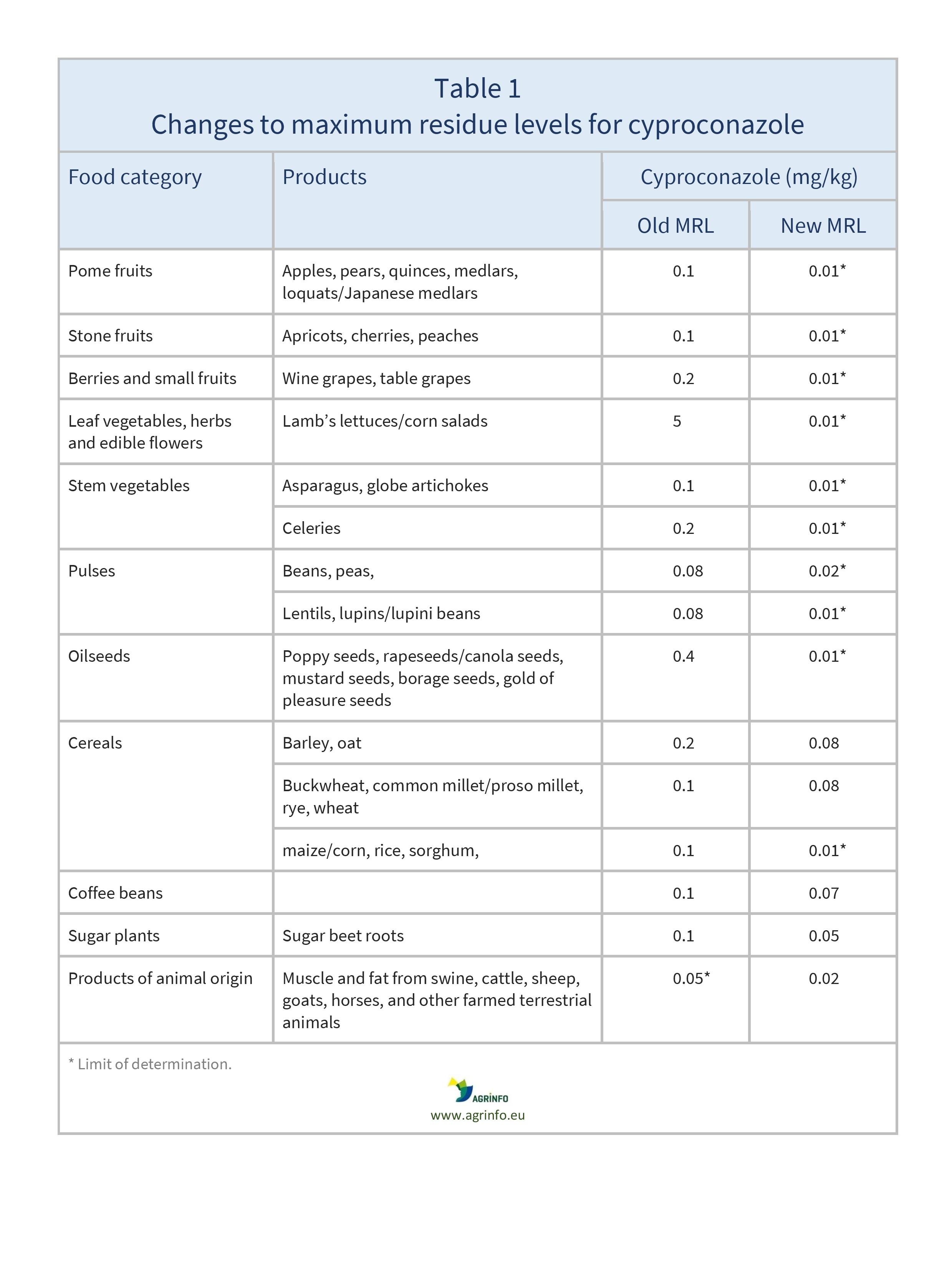Maximum residue levels for cyproconazole
- Food safety
- Pesticide MRLs
Summary
In September 2024, the European Parliament rejected a Commission Regulation that proposed to reduce the maximum residue levels (MRLs) for cyproconazole on certain products to the limit of determination (LOD, the lowest level that can be detected using the most modern and reliable analytical methods). See Maximum residue levels for benomyl, carbendazim, thiophanate-methyl, cyproconazole, and spirodiclofen.
The Parliament has requested the Commission to withdraw its draft Regulation and present a new one, setting all the MRLs for cyproconazole on all products to the LOD.
Parliament rejects Commission proposal to amend cyproconazole MRLs
Draft Commission Regulation amending Annexes II and III to Regulation (EC) No 396/2005 of the European Parliament and of the Council as regards maximum residue levels for cyproconazole and spirodiclofen in or on certain products
Update
In September 2024, the European Parliament rejected a Commission Regulation that proposed to reduce the maximum residue levels (MRLs) for cyproconazole on certain products to the limit of determination (LOD, the lowest level that can be detected using the most modern and reliable analytical methods). See Maximum residue levels for benomyl, carbendazim, thiophanate-methyl, cyproconazole, and spirodiclofen.
The Parliament has requested the Commission to withdraw its draft Regulation and present a new one, setting all the MRLs for cyproconazole on all products to the LOD.
Impacted Products
Apples, pears, quinces, medlars, loquats/ Japanese medlars, apricots, cherries, wine grapes, table grapes, lamb’s lettuces/corn salad, asparagus, globe artichokes, celeries, beans, lentils, peas, lupins/ lupini beans, poppy seeds, rapeseeds/ canola seeds, mustard seeds, borage seeds, gold of pleasure seeds, soyabeans, barley, oat, buckwheat, common millet/ proso millet, wheat, maize/ corn, rice, sorghum, coffee beans, sugar beet roots, muscle and fat from swine, cattle, sheep, goats, horses, and other farmed terrestrial animals
What is changing?
The EU proposed to reduce the MRLs for cyproconazole as summarised in Table 1.
Why?
Cyproconazole is no longer authorised in the EU because the manufacturer has not submitted a new application for approval. Therefore all MRLs should be set at the LOD.
However, some products for which CXLs are set have been reviewed by EFSA (2021), which concluded that they present no health risks for the consumer.
Timeline
The European Parliament’s objection prevents the Commission from adopting the proposed draft Regulation, which means that the existing MRLs for cyproconazole continue to apply.
Background
In January 2024, the EU informed the World Trade Organization Sanitary and Phytosanitary Measures (WTO SPS) Committee that it intended to reduce the MRLs for cyproconazole (G/SPS/N/EU/713) to the LOD. This would apply to all products except those for which MRLs are based on Codex MRLs (CXLs) or import tolerances, which are considered safe. There would be potential impacts on exports of certain fruits (pome fruits, stone fruits, berries), pulses, oilseeds, and cereals.
MRLs are set in accordance with the rules set out in Regulation 396/2005. For information on current MRLs for other substances, please consult the EU Pesticide Residues database.
Resources
EFSA (2021) Review of the existing maximum residue levels for cyproconazole according to Article 12 of Regulation (EC) No 396/2005. EFSA Journal, 19(3): 6483.
Sources
Draft Commission Regulation as regards maximum residue levels for cyproconazole and spirodiclofen in or on certain products
Tables & Figures

Source: based on PLAN/2023/1960
Disclaimer: Under no circumstances shall COLEAD be liable for any loss, damage, liability or expense incurred or suffered that is claimed to have resulted from the use of information available on this website or any link to external sites. The use of the website is at the user’s sole risk and responsibility. This information platform was created and maintained with the financial support of the European Union. Its contents do not, however, reflect the views of the European Union.
Parliament rejects Commission proposal to amend cyproconazole MRLs
Draft Commission Regulation as regards maximum residue levels for cyproconazole and spirodiclofen in or on certain products
What is changing and why?
In September 2024, the European Parliament rejected a Commission Regulation that proposed to reduce the maximum residue levels (MRLs) for cyproconazole on certain products to the limit of determination (LOD, the lowest level that can be detected using the most modern and reliable analytical methods) (see Table 1).
Timeline
The European Parliament’s objection prevents the Commission from adopting the proposed draft Regulation, which means that the existing MRLs for cyproconazole continue to apply.
Tables & Figures

Source: based on PLAN/2023/1960
Disclaimer: Under no circumstances shall COLEAD be liable for any loss, damage, liability or expense incurred or suffered that is claimed to have resulted from the use of information available on this website or any link to external sites. The use of the website is at the user’s sole risk and responsibility. This information platform was created and maintained with the financial support of the European Union. Its contents do not, however, reflect the views of the European Union.
